|
FAQs about Marine Worms, Vermiform Animals
Identification 14
Related FAQs: Worm
IDs 1, Worm IDs 2, Worm IDs 3, Worm
IDs 4, Worm IDs 5, Worm IDs 6, Worm
IDs 7, Worm IDs 8, Worm IDs 9, Worm
IDs 10, Worm ID 11, Worm ID 12, Worm ID
13, Worm ID 15, Worm ID 16, Worm ID
17, Worm ID 18, See
Also: Flatworm ID 1 +,
Nemertean, Proboscis, Ribbon Worm ID
1, Nematode, Roundworm ID
1, Nematomorpha, Horsehair Worm ID
1, Acanthocephalans, Thorny-headed Worm ID
1, Tubeworm/Featherduster ID
1 +, Bristle Worm ID 1 +,
Hirudineans, Leech ID 1, Sipunculids, Peanut Worm ID 1, Echiuran Worm ID 1, Worms 1, Worms 2,
Worms 3, Flatworms/Planaria, Fire/Bristleworms, FAQs on: Worm Behavior, Worm
Compatibility, Worm Selection,
Worm Systems, Worm Feeding, Worm
Disease, Worm
Reproduction,
Related Articles: Worms,
Featherduster Worms,
|
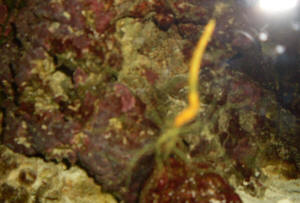
|
|
Worm id, Peanut 4/8/09
I've seen this worm on numerous occasions after the lights go
out.
Usually it retracts when I put a flashlight on it but tonight it
kept on going. I ended up capturing it. Greenish in color with
light yellow bands. I would guess it is approximately 14" in
length.
Thank you
Rick
<Looks to me to be a Sipunculid. See here:
http://wetwebmedia.com/pnutwrmidfaqs.htm
Bob Fenner>
|
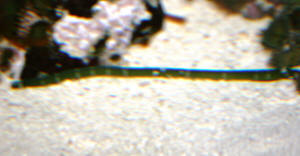 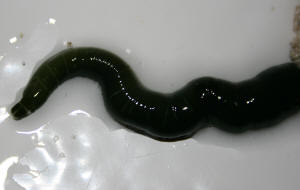 |
|
Worms, Lost and Confused: Ophiuroids and Aiptasia --
4/4/09
Hi there,
<Hello>
First of all, I have to tell you this is a great site for
information, however, that being said, I still have some
questions about strange worms I found in my aquarium.
<Okay>
The first one is long, thin, white/yellow with brown/black bands
- photo included. Can you help me?
<Yes, it's a neat little Ophiuroid/Brittlestar of some
sort. They're common, harmless and beneficial hitchhikers
that like to find protected crevices in the rockwork and extend
their arms out into the current to catch passing bits of
food.>
The second one is definitely uglier.
<Awwww, maybe it has a really nice personality though!>
Purplish with red tinge to it, looks almost hairy - bristle
worm?
<Nope, another Ophiuroid.>
Should I get rid of them?
<No need. I'd leave them in place, let them do their
thing, and enjoy them. For more information, please see this link
(as well as those at the top of the page) for more information:
http://www.wetwebmedia.com/brittlestars.htm >
The last photo is a small anemone in the tank, would this be a
pest or one I can keep?
<It looks like a pest anemone to me, namely Aiptasia. I'd
get rid of it before it has the opportunity to spread. Please see
the following link (and those related at the top of the page) for
more information, starting here:
http://www.wetwebmedia.com/marine/inverts/cnidaria/anthozoa/aiptasia/aiptasia.htm
Please help.
Thanks guys
<You're very welcome. Take care, LynnZ>
|
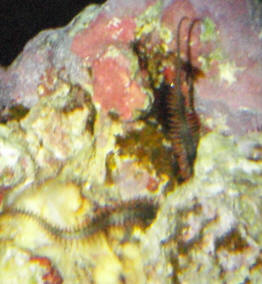 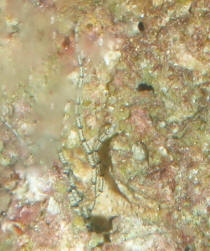
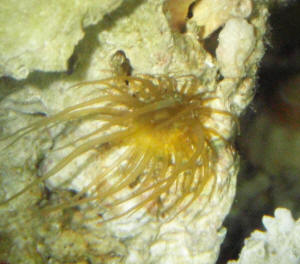 |
|
Can any one tell me what kind of worm this is? --
03/07/09 It came in with the sea lettuce from the
Florida Keys. What do they eat? Is it possible they could eat
seahorse fry? Thank you. Glen <Mmm, yes... is not a worm...
but a sea cucumber... Euapta lappa... Not likely to eat fishes.
See the Net re. Bob Fenner>
|
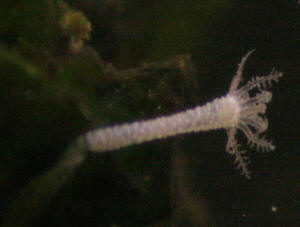 |
|
Please help 2/25/09 I've been struggling
to identify this worm. <Is a Errantiate Polychaete worm.>
I'm finding many of them in my tank. <Most tanks have
many.> Are they harmful and if so how do I get rid of them?
<Not usually. Generally, they are harmless scavengers, and
work to clean up your tank.> This picture is one I was able to
pull out during a cleaning. <Is a nice crisp picture. I
wouldn't be too worried unless you find one requiring more
than a 6 inch ruler to measure!>
|
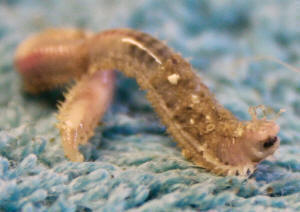 |
|
White Worm ID 02/24/09 I really need some
advice, and after looking thoroughly through WWM's worm ID
pages, I can't identify this worm. I'd sure appreciate
some assistance, and an idea as to whether it's harmful or
safe. This worm swims, and wiggles in the current. My clownfish
ate one last night. There were 2. I have no clue what it is.
<This looks like a Nassarius snail to me (not a worm). They
are generally beneficial scavengers. Lucky for you that you got
them without meaning to/paying for them. A lot of people buy
them.> I don't think it's a Bristleworm, because
it's white, or is it? <It's white and... it has a
shell! lol> Thank you in advance. Renee <Cheers, Sara
M.>
I think the writer is referring to the worm to the upper
left... This is an Errantiate Polychaete (a
"bristleworm"). RMF
Re: White Worm ID 02/24/09 Hi Sara, I sent
out a note and don't know if it went out of not, so I
apologize for sending this twice, however I think there has been
a bit of a mistake in your assessment of my worm. Although
blonde, and somewhat Californian in spirit, I don't think I
am quite blonde enough to mistake a snail for a worm.
<Heeeee!! I'm so sorry for the confusion. But if you saw
some of the queries we get sometimes, you'd understand...>
Hehe...therefore, if you could please take a second gander at the
photograph I sent you of my Nassarius Snail on the tank glass
next to the worm (a size comparison, where the size of the worm
becomes more apparent when next to a larger object [i.e.: my
snail}), I'd sure appreciate your time in doing so. <Ah, I
see now. I do think this is some type of bristle worm. There are
many different types/species... they also have different life
stages. The common red bristle worms we all love actually have a
stage where they are white and free swimming. This worm might be
in a transition phase? That would be my guess. But I'll let
Bob or Lynn comment if they have a different/better idea.>
Thanks again, Renee <Cheers, Sara M.>
|
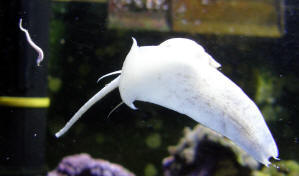 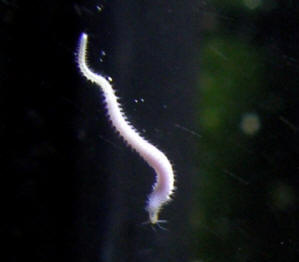 |
|
Regarding White Worm ID 2/24/09 Query
2/25/09 Good afternoon Sara and Bob! <Lynn> I just
saw my name mentioned in this query and figured I'd go ahead
and add my two cents. If the worm is swimming and wriggling
around in the water column, chances are it's an
epitoke/reproductive stage of some sort of errant Polychaete.
I'd love to see a close-up shot of it, but the relative
thickness around the anterior portion does bear a passing
resemblance to one I had in my tank several years ago. I
don't see the same obvious demarcation in the body but it
could be a different species, or at a different stage of epitoke.
I honestly don't know. Here's a link to a photo of the
one I had (a Nereid) for comparison:
http://bb.wetwebmedia.com/gallery/pic.php?mode=large&pic_id=219
http://bb.wetwebmedia.com/gallery/pic.php?mode=large&pic_id=221
There are also FAQ's with photos and more information
regarding these at our site. Hope y'all are doing well down
there in sunny California - or wherever you might be! Wish you
could send some of that good weather our way! Take care and have
a great day. -Lynn <Thank you. BobF>
|
|
Hard white worms?? 2/23/09 Hello, <Hi
Heather, Mich here.> I had a question about identifying
something I found in my filter of my saltwater tank recently. I
have had my tank for about a year and it is doing just fine. I
have a Picasso trigger fish and a flame angel fish as well as an
algae "lawnmower" blenny. I was doing a water change
and happened to notice some weird white things that looked like
small worms. They don't move at all and when I touched one it
was hard. I broke it open and there was something red inside of
it. I also found a few of these things on a magnetic glass
cleaner that I always keep in my tank. I didn't know what
these are or if they are something I should be concerned about.
Will they harm my fish or clog my canister filter? <They are
tiny feather dusters, part of the family Serpulidae and are
harmless, beneficial filter feeders. They will live happily in
your filter, their tubes are calcareous but stay pretty small and
usually attach pretty firmly. But you may have to remove a few
depending on their location. More here:
http://www.wetwebmedia.com/feather.htm > I really appreciate
the help!! <I'm happy to assist!> Thanks, Heather.
<Welcome, Mich>
|
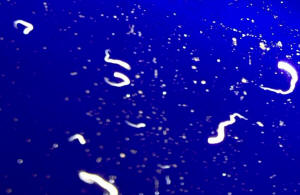 |
|
Worm ID: Errant Polychaete -- 2/21/09 Hi,
<Hi there.> What a wonderful website, <Why thank
you!> I need some help in identifying a worm. I have checked
all the worm Id's and Polychaete Id's, but came up empty
handed. Here are some pictures, they are best I could take. As
for the head, it looks very similar to a snake's head. It is
smooth, and has what looks like two small eyes (black points) It
does not have any antennae, but only what looks like a slit for a
mouth. I am not sure how long it is, but it retracts with
lighting speed. <Well, it's an errant Polychaete of some
sort -- possibly a Phyllodocid (family: Phyllodocidae). However,
I've never seen one with a completely smooth head. They
usually have multiple antennae and appear almost
'whiskered'. Another possibility is a Syllid (family:
Syllidae). Those in the subfamily Eusyllinae have more
blunt-looking heads without a lot of obvious appendages.
Unfortunately, there are a host of other possibilities as well.
I'd need some good close up shots of the head and legs in
particular to have any hope of narrowing it down. The good news
is that it's highly unlikely to pose any sort of threat to
your fish, corals, or larger invertebrates. These little worms
are mostly carnivores and detritivores, and what live food they
take is along the lines of small worms, 'pods', sponges,
hydroids, etc. If you're still interested in trying to ID
this little fellow and can get some good hi-res photos, please
send them along and I'll do what I can to help. Otherwise,
I've got some links for you to continue the search. The first
is a terrific site with detailed drawings of the various families
(be sure to see Phyllodocidae and Syllidae):
http://www.nhm.ac.uk/research-curation/research/projects/taxinfo/browse/family/family_browser.htm
Although the following is a key for identifying Polychaetes in
New Zealand, it's got some terrific general information
regarding various families:
http://www.annelida.net/nz/Polychaeta/ShorePoly/NZShorePolychaeta_ID.htm#QUICK
http://www.wetwebmedia.com/polychaetes.htm
http://www.chucksaddiction.com/hitchworms.html > Please help,
Thanks. <You're very welcome. Take care, Lynn>
|
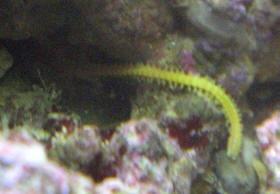 |
| Worm 1/31/09 How's it going? <About as
fair as can tell> I pulled this worm (it was floating around)
out of my 120g reef while cleaning the tank. The worm is about 2-3
cm when stretched out and it diameter is less than a millimetre
when stretched but fattens up when it contracts. Attached is
microscopic pic. Could you identify it and should i be concerned of
its presence? thanks <What nice pix! This is almost certainly a
nematode/roundworm... Not likely deleterious, though I would remove
it/them myself. This phylum is a huge assemblage of free-living to
parasitic species... Much more on the Net. Thank you for sending
this along. Bob Fenner> |
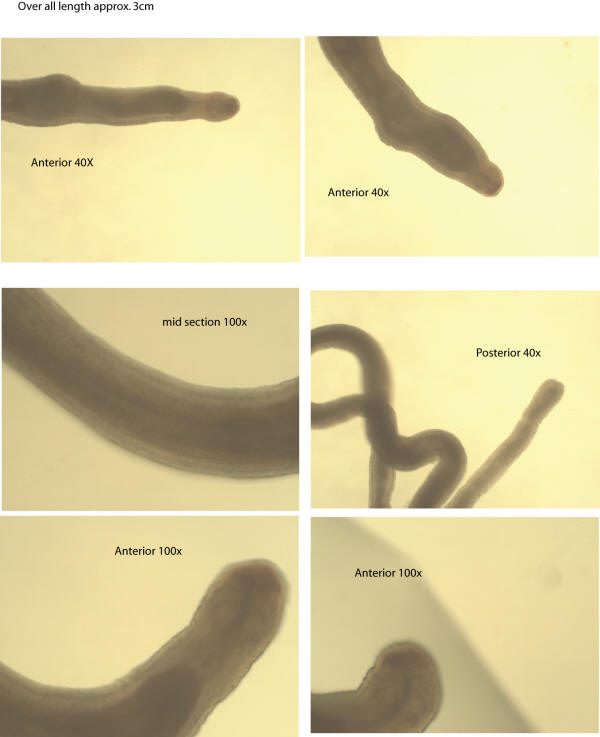 |
|
Worms 12/28/08 <Hello Chip. Minh at your
service.> Found these in my tank appear to stay in sand and
only have long tentacles protruding from the sand. What are
they?? Are they helpful or harmful? <Based on the pictures
provided, the worms appear to be Terebellid Polychaete or
commonly known as "Spaghetti Worms." There is also a
similar worm in the family Cirratulidae that is often times
mistaken for the "Spaghetti Worm." Both the Terebellid
Polychaete and Cirratulidae perform useful functions in aquaria
by facilitating the consumption and recycling of fine organic
debris such as minute particles of detritus. More information can
be found in this excellent article:
http://www.reefkeeping.com/issues/2002-06/rs/index.php.>
Thanks. <You're welcome. Cheers, Minh Huynh.>
|
 |
|
|

